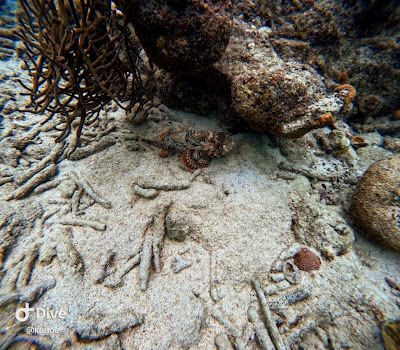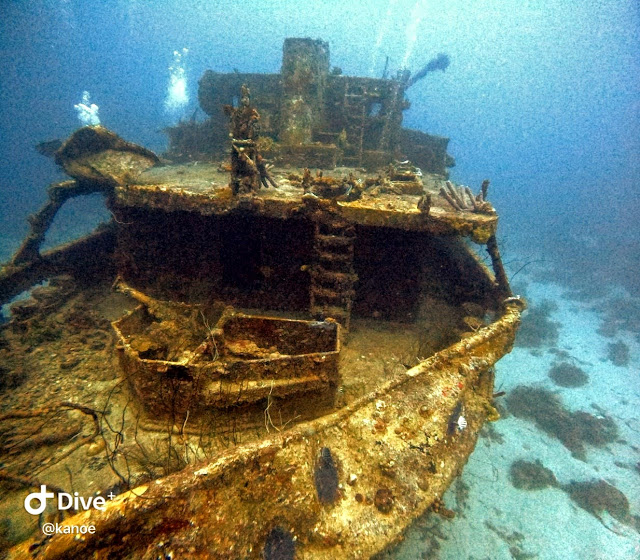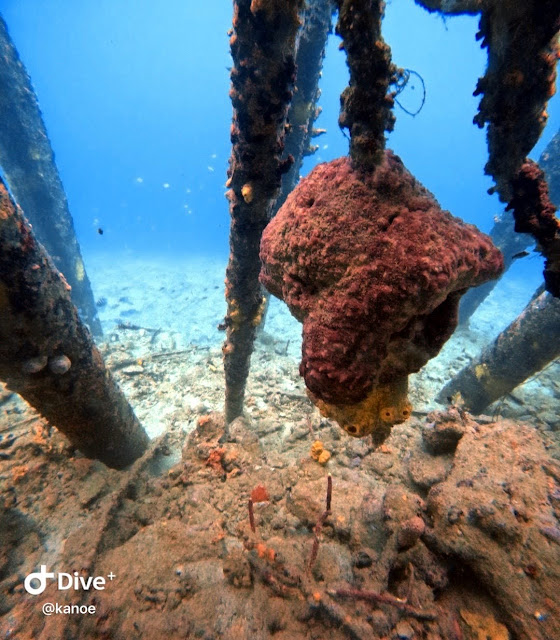Yes ... CORALS are Animals
______________________
Readers: The Blue information links are clickable
_______________
How We Got ... HERE
It's a 4.5 hour duration (by car and trains) from our home in Wellington to a hotel room in Toronto. Dry driving conditions and almost balmy weather for our car shuttle but a VIA Rail train delay from Belleville; added about an hour to our total travel time.
The flight to CURACAO was on schedule but Dann's personal suitcase didn't get on the 'dang' plane from Toronto.😒 Once we realized the baggage carousel was empty; it took us 30 minutes to register the issue with Westjet before we could take our shuttle to Papagao Beach Hotel and Resort and then another 45 minutes to travel across the island from Curacao International Airport. We were contacted later by Westjet and informed the missing suitcase had been located and would be sent on an Air Canada flight arriving the next day. Arrangements have been made to have it delivered to our hotel. UPDATE: 😁My luggage arrived within the next 24+ hours.
CURACAO is a constituent country of the Kingdom of the Netherlands. Together with ARUBA and BONAIRE, it forms the ABC Islands.
... here's a map.
__________________________
View PHOTOS Only ... Options
Option 1
If you prefer to skip over all the (often boring, diving-related 😕) text that I've written to accompany this post; click on any image or photo. That will launch a minimized gallery on your screen that you can then scroll (< >) through. This will also displays all photos in full screen format.
Option 2
Or, for all photos (163 of them); go to this trips Google Album ... here.
 |
| Stock Photo |
 |
ROMATIC |
 |
Helen's Happy Feet |
 |
Venezuelan Troupial ... largest member of the Oriole family |
.JPG) |
Yellow-headed Amazon Parrot |
 |
Iguana |
.JPG) |
Punta Vibes UNESCO WHS |
.JPG) |
Queen Emma Bridge |
_______________________________
If YOU Go ... SHORE Diving with FUN DIVING
For more details on their operational procedures and the services they provide to divers, go here.
My first 2 dives were done from the house shore reef, directly in front of the Fun Diving shop located near the south west corner of the resort. Entry is a big leap or a ladder descent from a small deck area to an initial coral bottom of 15' or so. They have a small retail shop that includes classroom facilities and an equipment area for gear repair and maintenance.
A second area nearer the waterfront, includes a covered gear set-up area, some rinse tanks and drying racks for all gear and electronics; lockers are available to secure gear overnight.
In many dive sites along CURACOA's Fringing Reef, divers who are shore diving may encounter small craft boat traffic (fishing boats, seadoos, catamarans etc) and it is recommended they tow a buoy with a PADI Diver Down flag visible. The house reef in front of Papagao Beach (Diver's Leap to Sweet Bottom) is easily identified by a dramatic colour change under most conditions; but heavy wave action, lack of boat operator knowledge or inconsideration has the potential for serious injury.
All my remaining, 2-tank morning dives involved loading the gear for an ever-changing number of divers into a pickup truck and driving to a shore dive location somewhere on the island. Water, soft drinks and snacks (fruits, cookies) are available throughout the dives. The longest turnaround time in my case and based on the sites chosen, a 2-tank morning that included return was 5 hrs (9am - 2pm).
_____________________
At The CURACAO Dive Sites
Explanations
max depth/max bottom time
A Firstime Wildlife Sighting/Experience = *
A PB (Personal Best (new or equaled)) = *
Curacao Scuba Diving & Snorkeling Guide (map is interactive)
__________
The DETAILS
# of Dives: 🐢🐢🐢🐢🐢🐢🐢🐢🐢🐢
Site Names: Divers' Leap (92'/59 min), Sweet Bottom (96'/53 min), MV Superior Producer (102'/32min), DoubleReef (74'/46min), TugboatWreck (49'/66 min), Bachelor's Beach (72'/71 min* ), Marie Pampoen Beach (67'/57 min ), Atlantis Beach H0use (59'/55 min ), Directeurs Baii (65'/59 min), Caracas Baii (50'/59 min)
Dive Master(s): Brad (4), Jordan (6)
DM/Diver Ratios: 1:1/1:2/1:3
Average Maximum Depth/10 Tanks
(92+96+102+74+49+72+67+59+65+50)/10 = 72.6 feet
Average Bottom Time/10 Tanks
(59+53+32+46+66+71+57+55+59+59)/10 = 55.7 min
Total Underwater Bottom Time = (59+53+32+46+66+71+57+55+59+59) = 557 min = 9 hr 17 min
Number of Small 🐟: 10's of thousands
Firstime Wildlife Sightings/Experiences: * hogfish * fish ball
____________
WHAT I SAW 🤿
While diving, I used a GoPro Hero 11 Black camera with a Telesin waterproof housing and FitStill handgrip. Underwater colour correction has been performed using the Dive+ app. All diving photography is mine; unless noted.
The following photos were taken at the dive SITES listed above and are (mostly) in chronological order.
_____
LINKS
DISCLAIMER: The animals featured in the photos are often linked to various scientific knowledge sources; providing the most reliable and trusted information I could find. Please contact me if you have contradictory evidence that proves otherwise; and I will make any appropriate corrections.
So, if you are interested in marine life and would like to learn more; click on any of the blue caption links below any photo.
 |
The landscape at Divers' Leap just before the reef wall and a descent to 92' |
 | |
| Small colonies of Christmas Tree Worms | DEFENSE Despite their vibrant appearance, Christmas Tree Worms face threats from various marine predators. Fish, crabs, and certain species of snails feed on these colorful worms. Their ability to quickly retract into their protective tubes serves as a crucial defense mechanism against potential predators. |
 | ||
| Sea Cucumber | DEFENSE When threatened, some sea cucumbers discharge sticky threads to ensnare their enemies. Others can mutilate their own bodies as a defense mechanism. They violently contract their muscles and jettison some of their internal organs out of their anus. (Stock Photo) |
 |
Sharp-tailed Snake Eel |
 | |
| Trumpetfish | DEFENSE Because they are extremely weak swimmers, trumpetfish sometimes rely on camouflaging themselves by “standing” vertically (not the case here) amongst sea whips and other gorgonians for both defense from predators and in order to catch prey. |
 | |
| Sea Anemone | DEFENSE The defensive behavior is characterized by the compression of the body, extension of tentacles, and ejection of acontia. This form enables the anemone to shield the oral disk using cnidocytes in the tentacles and protect the body using acontial stinging cells. |
 | |
| Boxfish 1" long juv. (rt. side of coral) | DEFENSE When stressed, these fish will release a toxin as a defence mechanism called pahutoxin, and this makes them an experienced keeper's fish. This toxin is fascinating, unique to the boxfish family in the underwater world, and is a surfactant. |
 | ||
MV Superior Producer | GOING DOWN Word of the sinking spread across Curaçao like wildfire. Scuba divers, free-divers and snorkelers alike arrived on the shoreline from all over the island to scavenge the wreck for all its cargo. It was described as ‘pure chaos’ at the time, and within a few days, there was nothing left – even the neglected portholes had been taken. Curaçao’s Christmas market was well-stocked with an abundance of blue jeans. |
 |
Lionfish on the barrel. Can you find it? DEFENSE Lionfish spines contain a nasty neurotoxin that causes pain and swelling if injected. They use their spines as a defense mechanism from predators. |
 |
Fat Tarpon at 40' distant |
 |
Coral Reef Restoration Platforms |
 |
Tugboat Curacao |
 | |
Scorpionfish | DEFENSE Located on its dorsal, anal, and pelvic fins, numerous spines serve as a formidable defense mechanism. If threatened or disturbed, the fish will raise its spines, presenting a warning to potential predators or intrusive underwater photographers! |
 |
Tugboat Beach Pier pillar |
 |
Divers heading under Tugboat Beach Pier |
 | |
Hawksbill Sea Turtle | DEFENSE The hawksbill is distinct among the sea turtles. It has a beaklike mouth that is curved and sharp, helping the turtle protect itself and eat. This is the only turtle with overlapping scutes (plates) on its shell. |
 |
Sand Diver DEFENSE Sandy and silty structures are preferred as it offers protection from predators because they tend to snuggle themselves under the sand with only their head being visible for protection. They have the ability to camouflage against rocks and this is also used as a defensive mechanism. Their movements are so fast that they become invisible in motion . |
 |
Seahorse DEFENSE A seahorse's lack of mobility is compensated for by fascinating defense mechanisms. One such mechanism is the ability to camouflage itself by rapidly changing colors in order to blend into their surroundings (not the case here) and evade predation. Another defense mechanism used is mimicry in which some seahorses have adapted appendages that allow them to hide among algae and corals |
 |
Surrounding us ... |
 |
Passing us ... |
 | ||
Hogfish | LIFECYCLE The hogfish is a sequential hermaphrodite, meaning it changes sex during different life stages; it is a protogynous, "first female" hermaphrodite; juvenile hogfish start out as female and then mature to become male. Hogfish social groups are organized into harems where one male will mate and protect a group of females in his territory. |
 |
Elkhorn Coral With a width of (approx.) 6 foot, this specimen is actually small; given the species can reach widths of 43 feet. _____________ Where To Next ? ... LOAFin Around somewhere in CANADAs' East Coast. _____________________________ We're LOAFin Around Helen's much more photogenic, I 😎 took the photo. ... follow along, if you like. Refer to our Trip164 gallery for all photography for this trip. Cameras #1 - GoPro Hero 11 with TELESIN underwater housing #2 - iPhone 11 Unless noted, all content is by LOAFin Around. _____________________________ |


.JPG)
.JPG)
.JPG)
.JPG)
.JPG)
.JPG)
.JPG)
.JPG)
.JPG)
.JPG)
.JPG)
.JPG)
.JPG)
.JPG)


.JPG)

.JPG)
.JPG)












No comments:
Post a Comment
Your comments, suggestions, observations and even opinions are welcome ... please leave some!